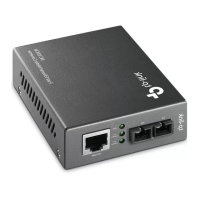
Do you have a question about the TP-Link MC100CM and is the answer not in the manual?
| Fiber optic connector | SC |
|---|---|
| Connectivity technology | Wired |
| Ethernet LAN (RJ-45) ports | 1 |
| Wavelength | 1310 nm |
| Maximum transfer distance | 2000 m |
| Storage temperature (T-T) | -40 - 70 °C |
| Operating temperature (T-T) | 0 - 40 °C |
| Storage relative humidity (H-H) | 5 - 90 % |
| Operating relative humidity (H-H) | 10 - 90 % |
| Internal | No |
| Certification | FCC, CE |
| Product color | Black |
| LED indicators | Yes |
| Networking standards | IEEE 802.3, IEEE 802.3u, IEEE 802.3x |
| Cable types supported | Cat3, Cat4, Cat5, Cat5e |
| Ethernet interface type | Gigabit Ethernet |
| Maximum data transfer rate | 1000 Mbit/s |
| Fiber ethernet cabling technology | 100BASE-FX |
| Power consumption (max) | 2.5 W |
| Package depth | 204 mm |
| Package width | 165 mm |
| Package height | 65 mm |
| Package weight | 380 g |
| Depth | 73 mm |
|---|---|
| Width | 94.5 mm |
| Height | 27 mm |
Warning about Class A product and potential radio interference in domestic environments.
Explains MC100CM/MC110CS as Fast Ethernet and MC111CS/MC112CS as WDM Fast Ethernet Media Converters.
Clarifies terms like 'Converter' and 'TP port' used throughout the user guide.
Details standards compliance, connectors, auto-negotiation, LFP, extended distance, and LED indicators.
Lists supported connectors (RJ-45, SC) and network cables (Cat.5, multi-mode, single-mode fiber).
Explains the function of various LED indicators on the converter for network status monitoring.
Details the DIP switch functions for configuring port settings, duplex modes, and LFP.
Explains how the LFP function helps detect and report link failures between connected devices.
Describes the usage of MC100CM and MC110CS for different fiber types and wavelengths.
Details the usage of MC111CS and MC112CS for WDM technology on a single fiber.
Provides step-by-step instructions for connecting converters to TX devices and FX devices.